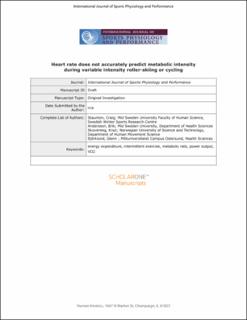| dc.contributor.author | Staunton, Craig A. | |
| dc.contributor.author | Andersson, Erik P | |
| dc.contributor.author | Skovereng, Knut | |
| dc.contributor.author | Björklund, Glenn | |
| dc.date.accessioned | 2023-03-17T08:06:30Z | |
| dc.date.available | 2023-03-17T08:06:30Z | |
| dc.date.created | 2022-12-16T11:21:46Z | |
| dc.date.issued | 2022 | |
| dc.identifier.citation | International Journal of Sports Physiology and Performance (IJSPP). 2022, 17 (12), 1664-1671. | en_US |
| dc.identifier.issn | 1555-0265 | |
| dc.identifier.uri | https://hdl.handle.net/11250/3058914 | |
| dc.description.abstract | Purpose: To critically appraise the utility of heart rate (HR) and power output (PO) to predict metabolic rate (MR) and oxygen consumption ( ˙ V O 2 ) during variable-intensity roller skiing and cycling. Methods: National-level cyclists (n = 8) and cross-country skiers (n = 9) completed a preliminary session to determine ˙ V O 2 max , and a variable-intensity protocol with 3 high-intensity stages at 90% ˙ V O 2 max for 3 minutes interspersed with 3 moderate-intensity stages at 70% ˙ V O 2 max for 6 minutes. Cardiorespiratory measures were recorded throughout. Linear HR–MR, HR – ˙ V O 2 , PO–MR, and PO – ˙ V O 2 regressions were computed from the preliminary session, individually, for all athletes and used to predict MR and ˙ V O 2 from both HR and PO, separately, during the variable-intensity protocol. Mean differences with 95% limits of agreement (LOA) between measured and predicted MR and ˙ V O 2 were calculated. Results: MR and ˙ V O 2 estimated from HR displayed a mean bias close to zero but wide LOA. HR overestimated MR and ˙ V O 2 during moderate intensity but underestimated MR and ˙ V O 2 during high intensity, for both roller skiing and cycling. MR and ˙ V O 2 estimated from PO were more consistent across the experimental trial, displaying a mean bias farther from zero but with tighter LOA. Conclusions: This study has demonstrated that HR has limited utility to predict metabolic intensity during variable-intensity roller skiing and cycling because of wide LOA. On the other hand, metabolic intensity predicted from PO had tighter LOA, suggesting better consistency. PO might provide a better prediction of metabolic intensity compared with HR, particularly when longer-duration steps are performed during preliminary testing. | en_US |
| dc.language.iso | eng | en_US |
| dc.publisher | Human Kinetics | en_US |
| dc.rights | Navngivelse 4.0 Internasjonal | * |
| dc.rights.uri | http://creativecommons.org/licenses/by/4.0/deed.no | * |
| dc.title | Heart Rate Does Not Accurately Predict Metabolic Intensity During Variable-Intensity Roller Skiing or Cycling | en_US |
| dc.title.alternative | Heart Rate Does Not Accurately Predict Metabolic Intensity During Variable-Intensity Roller Skiing or Cycling | en_US |
| dc.type | Journal article | en_US |
| dc.type | Peer reviewed | en_US |
| dc.description.version | acceptedVersion | en_US |
| dc.source.pagenumber | 1664-1671 | en_US |
| dc.source.volume | 17 | en_US |
| dc.source.journal | International Journal of Sports Physiology and Performance (IJSPP) | en_US |
| dc.source.issue | 12 | en_US |
| dc.identifier.doi | 10.1123/ijspp.2022-0114 | |
| dc.identifier.cristin | 2094273 | |
| cristin.ispublished | true | |
| cristin.fulltext | preprint | |
| cristin.qualitycode | 1 | |

